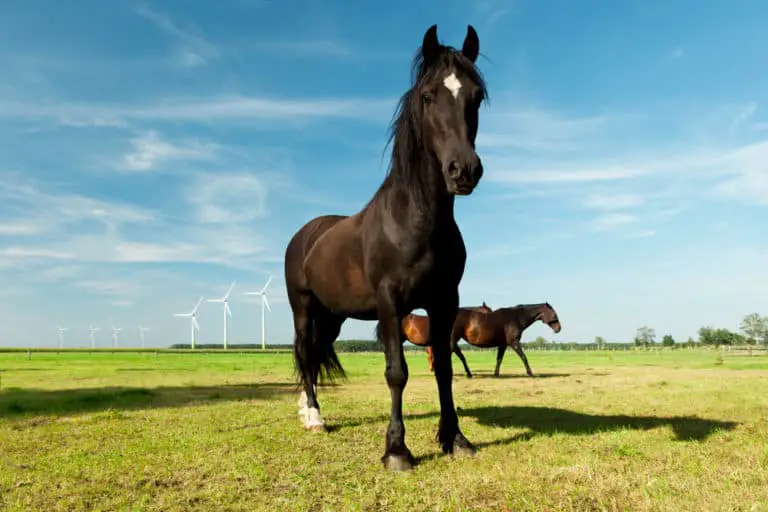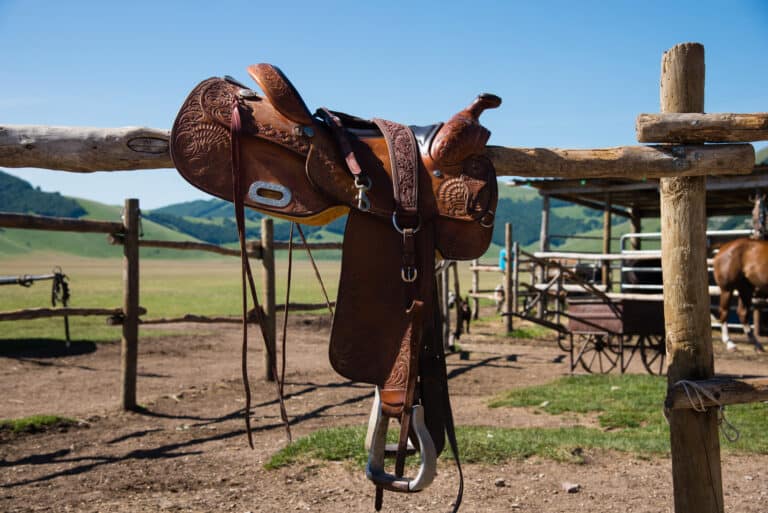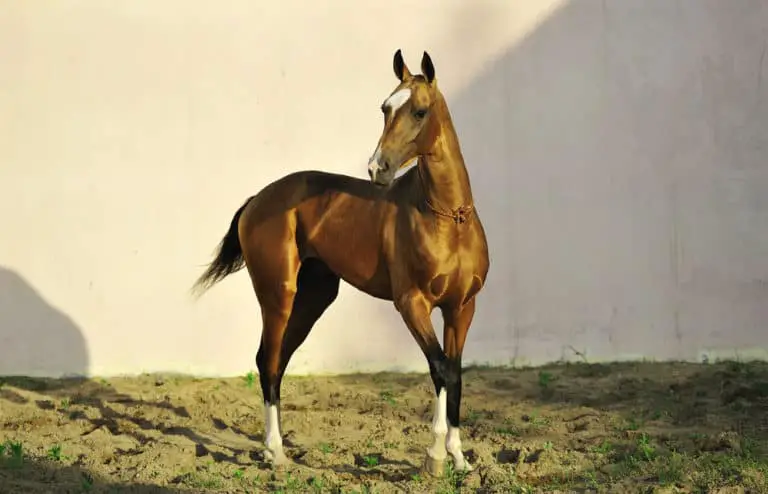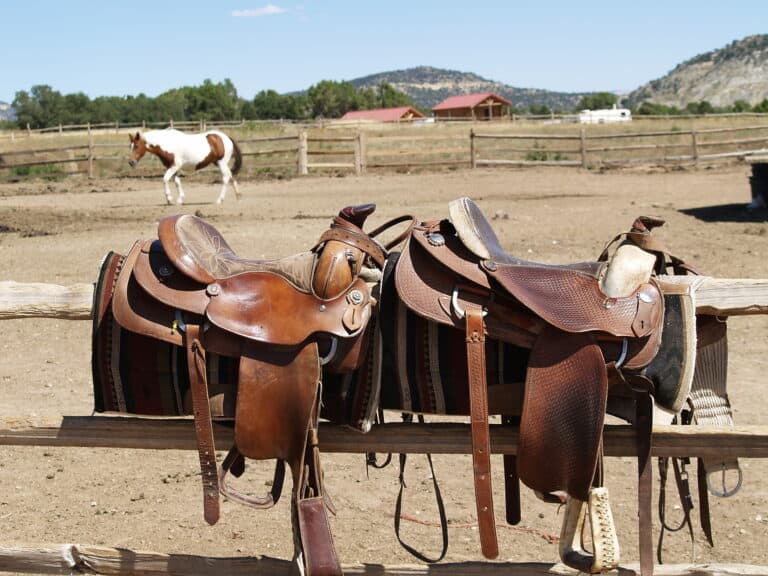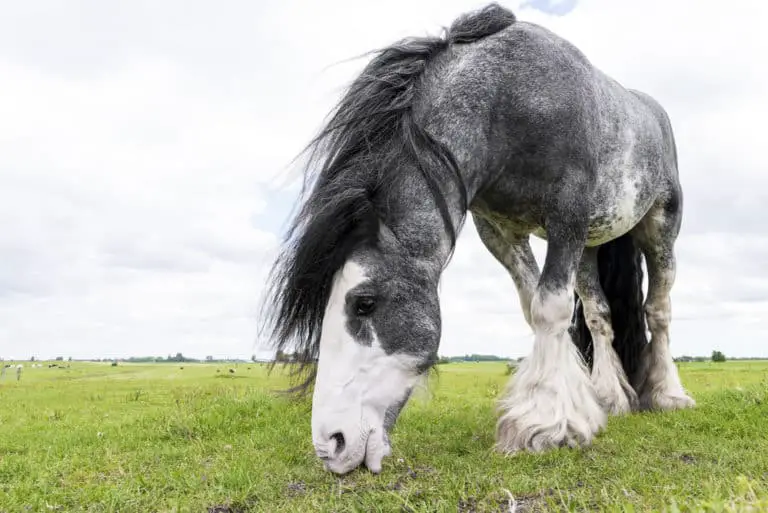Connemara Pony Breed: Care, Cost & History (2024)
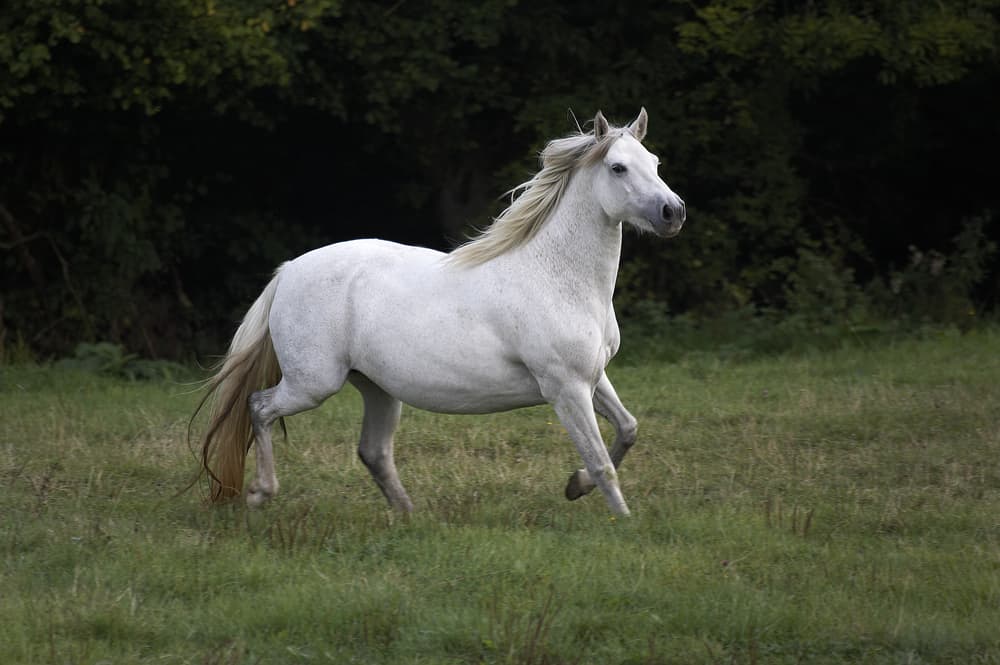
The Connemara Pony is a popular breed in Ireland, the United Kingdom, and the United States where they are used by children and adults as sport ponies. The breed is known for its jumping ability, endurance, beauty, and friendly demeanor. They developed in the harsh climate of western Ireland and are hardy and easy to care for.
Breed: Connemara Pony
Adult Weight: 639-860 pounds
Adult Height: 13-15 hands (52-60 inches)
Origin: Ireland
Use: Sport disciplines and showing
Colors: Grey and buckskin are the most common
Features: Refined, beautiful head, athletic body
Lifespan: 30-40 years
Character: Good temperament, intelligent, hardy
Gait: Sure-footed, with a ground-covering stride
Best for: All levels of riders
- Characteristics
- Connemara Pony Care
- Connemara Pony History
- Modern Connemara Pony
- Cost and Ownership
- Buying a Connemara Pony
- Similar Breeds
Connemara Pony Characteristics
The Connemara Pony characteristics are refined and athletic with a compact body and good bone. The Connemara Pony head has wide-set eyes and a broad forehead. The chest is deep and broad, and the ribs are well sprung; these features aid in their stamina and endurance. They are long and muscular in the leg with strong feet.
Size
Connemara Pony height is a distinguishing characteristic of the breed. The breed standard states that they are between 13 and 15 hands, or 52 to 60 inches. (1)
This means the taller ones actually qualify as horses. However, the most common height is 14 to 14.2 hands, so these are true ponies. Non-adults will reach their mature height by five years of age.
Luckily, Connemara size doesn’t limit their abilities to do different things, and it may be one of the reasons they are such excellent jumpers and sport ponies. Their size also makes them the largest of all the pony breeds.
Weight
Connemara Pony weight ranges from 639 to 860 pounds, depending on the size and bone structure of the particular pony. Those that fall into the range of Connemara horses tend to be heavier than the shorter members of the breed.
All are compact horses with deep and muscular bodies, and their bone structure has evolved over generations to easily support them. The bones are clean and flat and considered substantial in size for their height.
The Connemara foal will weigh 10% of its mother’s body weight at birth and be 50% of its adult weight by the time it reaches six months old.
Colors
Through hundreds of years of breeding, Connemara Pony colors have evolved into two primary colors, grey and buckskin. The buckskin is sometimes referred to as dun too. Other colors found include chestnut, bay, black, brown, palomino, and roan. Both grey and buckskin are dominant gene traits, hence one reason there are so many.
Rare Connemara Pony colors are black points and blue-eyed cream. The blue-eyed cream is a cremello coloring. Paint is not an acceptable color and cannot be registered. They can have white markings on their face or legs, including a star or blaze, and socks on the legs.
Temperament
Connemara Pony temperament is famous for being so good-natured and friendly. They have an incredible ability to bond with people, making them beloved by the children and adults who know, own, love, and ride them.
Connemara Pony temperament is kind and gentle, and this is one of the reasons they make such great animals for all levels of riders, including beginners. They are also mannerly and intelligent. This combination allows them to help their beginner riders through any tough situations.
The United States Equestrian Federation rules for the Connemara breed state that stallions can be exhibited by children and junior exhibitors unless the prize list of the particular show states otherwise. (2)
Connemara Pony Care
Connemara Ponies are easy to care for and a hardy breed that requires the basics, but no frills. Their care includes diet and nutrition – their feed and board, veterinary and hoof care, and grooming. If they receive these, they are pretty happy, and the Connemara Pony lifespan will be 30 to 40 years.
Diet and Nutrition
The Connemara diet should be kept relatively simple for a couple of reasons. First, they are a hardy breed that developed in a harsh area of western Ireland, so they don’t require a lot of feed or nutrient-dense feed. (3)
Second, because of the way they developed, and the health hazards that ponies experience when they are overfed, they should not be overfed. That being said, they require less feed than a regular-sized horse. (3)
The diet and nutrition should consist of hay and grass. They may also need grain or nutritional supplements, depending on the quality of the hay and grass. Access to clean water is essential at all times. (4)
Health Problems
Overall, the Connemara Pony breed is very healthy and tends to live a long, happy life. Again, this is thanks to the genetics that developed alongside the breed in the challenging climate of western Ireland.
However, they are predisposed to some genetic problems, including Hoof Wall Separation Disease (HWSD). This is when the outer hoof wall cracks and separates from the rest of the hoof. Ponies that have this usually show symptoms of the disease before they are six months old. (5)
There is a DNA test available and all registered Connemaras must have the results of their test on file with the breed association. (6)
Grooming
Grooming is a daily activity that all horse owners participate in. It helps bond with the horse, checks for any issues, and keeps their skin and hair healthy. Connemara grooming is enjoyable for both the horse and pony because the breed is so friendly and gregarious. (7)
Hooves should also be cleaned daily to prevent dirt, mud, and bacteria from getting packed in and creating problems for the pony. (7)
The Connemara has a pretty spectacular mane and tail, they are full and beautiful, especially on those ponies that are showing. Extra care and time should be given to carefully picking out the mane and tail to keep the hair healthy and fabulous. (8)
Connemara Pony History
The ancient Celts of western Ireland were always skilled horsemen. When the Spanish Armada sank off their coast in the 1500s, their horses swam ashore and bred with the horses in Ireland. And so the Connemara Pony history begins. The Connemara region is desolate with rocky mountains, moors, and bogs. Farmers began carefully breeding their Connemaras.
Origin
The Spanish Armada legend is just one thought about Connemara Pony origin. These would have been Andalusians, which would explain the refinement and beauty we see in the breed. Another theory is that the Connemara descends from the Scandinavian horses that the Vikings brought with them.
The Irish Hobby was a horse breed that was prevalent in Ireland in the 13th century, and it’s thought that this breed also influenced the Connemara. The truth probably lies in a mixture of these stories, with the Connemara developing from native horses and those brought to the country by both the Scandinavians and Spanish.
Historic Development
The early horses are thought to have fended for themselves in the rough landscape. But, local farmers were also struggling to survive and started keeping horses. Mares were prized because they could help with fieldwork, be ridden, and produce a foal each year.
Arabian blood was introduced in the 1700s to add speed and stamina. Thoroughbreds and Hackneys were also crossed with the breed at various times.
Then, in 1923, the Connemara Pony Breeders Society was established to protect, preserve, and promote the breed. They closed the registry to outside bloodlines in 1926. Since then, other breed organizations have been established throughout the world with similar goals.
Notable Connemara Ponies
Many of the famous Connemara Ponies we hear about today became famous because of their ability to jump ridiculously tall fences. These are ponies that cleared seven feet, competed in the Olympics, and provided countless joys to their owners. The Connemara Pony pedigree ensures that every member of the breed is spectacular.
Hideaway’s Erin Go Bragh
Hideaway’s Erin Go Bragh was a Connemara stallion, foaled in 1983, who competed at the Olympic Games in eventing. He technically qualified as a Connemara horse because he was 14.3. Go Bragh, as he was called, was known for his athleticism and kind temperament. He also successfully competed in driving and sired over 200 foals.
Nugget
Nugget was a Connemara gelding that became famous for his ability to jump really big jumps. He was 22 years old in 1935 and set a world record by clearing a jump that was 7’ 2” tall. That feat has since been accomplished by other Connemaras but Nugget was the first. He won over 300 awards.
Stroller
Stroller was also a Connemara gelding, and the first pony to compete in the Olympics. At 14.1 hands, he was not large, but he was athletic. Stroller was one of only two horses to jump clean in the showjumping competition at the 1968 Olympics and also won an individual bronze, representing Britain.
Myths and Legends
The Connemara Pony legends are as famous as some of the horses themselves. There’s a certain amount of magic in Ireland, and the Connemara breed inherited quite a bit of it. Horses had to be pretty special to survive here and then continued developing unique traits that have carried over to modern horses.
The Spanish Armada
The Spanish Armada sank off the coast of Galway in 1588. Phillip II had sent a fleet of 130 ships to invade England, and many sank here while returning home after being defeated. About 24 of the ships sank. The horses scurried into the mountains and developed sure-footedness because one wrong step in the tough terrain meant death.
Mare People
The farmers were also struggling to survive in the harsh Connemara region. They captured horses in the mountains and tamed them, but each farm could only afford one horse so selected a mare. They wanted horses that were smart, kind, and gentle. If their mare didn’t fit these qualities, they got a new one.
Little Squire
Little Squire was little, there’s no other way to put it. He only stood 13.2 hands, making it easier to understand where the “little” in his name comes from. But, he was not to be outdone by Nugget and jumped a 7-foot fence in 1935 at Madison Square Gardens in New York City.
Modern Connemara Ponies
Today, the Connemara is one of the most popular horse breeds because of its incredible athleticism and jumping ability, people-oriented personality, and beauty. There are different types of Connemara Ponies within some breed associations, these are grades designated by age and height, but all members of the breed have the main characteristics that have made them famous.
Breeding
The Connemara is found throughout the world today. There are breed associations in Ireland, Great Britain, the United States, Australia, Austria, Belgium, Canada, Norway, Switzerland, and many others. Connemara breeding is popular with all types of people, but there are not as many Connemaras available as there are people seeking the breed for horse ownership.
Each of the breed associations throughout the world has a list of farms with Connemara Ponies breeding to help those interested find a pony or connect with other breeders. Most are bred for sport horse disciplines like jumping and dressage but the ponies can excel at anything.
Population
Most of the population is found in Ireland and the United Kingdom, although there is a healthy population of Connemaras in the United States too, and in the 16 other countries throughout the world with breed populations.
In Ireland, the Connemara Pony population is small, with only about 2,000 mares and 250 stallions. (9) Population numbers in the other countries vary, but it’s generally accepted that Ireland is the largest population. Inbreeding is one challenge that breeders in all locations are cognizant of and trying to mitigate. (10)
The breed is endangered, and many are striving to further develop them. They are endangered because there are relatively few in each location when compared with demand.
Uses
The original uses of the Connemara were often for work on the farms in Ireland, and the breed could still be used for work, but they are used more for sport and pleasure in recent history.
Connemaras are fantastic choices in the Olympic disciplines such as eventing, show jumping, and dressage. Although they were bred for this purpose, Connemara Pony uses extend beyond these and include driving, foxhunting, western pleasure, and whatever else their rider wants to do.
Most Connemaras are comfortable to ride and their Connemara Pony gait is fluid, energetic, and sure-footed. They have ground covering strides, and are smooth enough to give beginner riders the confidence they need.
Connemara Pony Prices
A pony may be smaller than a regular-sized horse but that doesn’t mean the price is smaller. The Connemara Pony price is just as much, if not more than a regular-sized horse because of their popularity. It also includes the related costs that incur monthly for the board, feed, veterinary, and hoof care. These are expensive over time.
Purchase Price
The purchase price of Connemara Pony is between $7,000 and $15,000. (11) This is a one-time expense, with the Connemara, is considered an expensive breed. Their athleticism, size, good temperament, and relative scarcity all contribute to the higher purchase price.
A foal or young horse will cost less, as will an older horse that’s closer to retirement. An animal with Connemara Pony training will cost more as you can get on and go, rather than investing in training yourself.
There are also some exceptions to the price range – horses with a lot of potential or a show record like Stroller or Nugget will cost more.
Ownership Costs
Most people plan for purchasing a horse, but don’t always think about what happens after they’ve paid the original Connemara price and gotten the horse home. The essential costs of board, or where the horse lives, feed, veterinary, and farrier care all need to be incorporated into the Connemara Pony cost of ownership.
Board
The Connemara may have survived the harsh climate of western Ireland, but they do enjoy their stalls and barns! Connemara Pony board cost is between $1,200 and $7,200 per year. A horse with a run-in shed and pasture may be on the lower end, whereas show ponies in a fancy stable will be on the higher end. (12)
Feed
Feed expenses can really add up but will vary based on geographic location and the amount of grass the horse or pony has access to. Therefore, the range for Connemara Pony feed cost is from $250 to $4,380 per year. This will include any nutritional supplements and grain as well. (12)
Veterinary Care
A veterinarian is an important person in the life of any horse or pony. They visit and provide vaccinations, dental care, and deworming, all essential for the overall health and well-being of the pony. The Connemara Pony veterinary cost is $250 to $350 annually. Injuries and accidents will incur additional costs. (12)
Hoof Care
The farrier is another important person, they take care of trimming the hooves every six to eight weeks, and applying shoes when needed. Connemara Pony hoof care cost is $120 to $1,000 annually. The cost is spread out over each visit, and shoes push it towards the higher end of the price range. (12)
Buying a Connemara Pony
Lots of children dream of having a pony of their own. The Connemara breed can make that dream come true, even if the child has become an adult. Buying a pony isn’t something to be taken lightly though. Understand the goals you have for the horse and your level of horsemanship before starting the search process.
Is the Connemara Pony Right for You?
Owning a Connemara is right for you if you’re looking for a partner that you can have fun with. They are also the right breed for you if you want to be competitive at horse shows and in the ring. Finally, they are the right horse for you if you are new to riding and want to build your skills and confidence.
Riding a Connemara Pony offers something for everyone. While some are versatile and can switch between rider skillsets, most enjoy having a mature rider that understands equine behavior.
How to Buy a Connemara Pony?
Those interested in buying a Connemara Pony should start by listing out what they are looking for in their pony or horse. Then, make a plan for how you can contact and visit some breeders to learn more about the horse.
A Connemara breeder will be excited to have other horse enthusiasts to discuss the breed with. If you explain what you want in a horse or pony, they will help match you with the correct breeder. In some cases, you may need to patiently wait or a horse to be available.
Avoid any animal with a bad temperament and poor endurance, as these are consistent traits found throughout the breed.
Similar Breeds to Connemara
Many people dream of owning a Connemara and fulfill that dream. However, there are Connemara breed alternatives too. The Dales Pony, Gypsy Cob, and Kerry Bog Pony all developed in England and Ireland. The Dales are similar in size and disposition, while the Gypsy Cob shares disposition traits too. The Kerry Bog Pony also has an Irish lineage.
Dales Pony
The Dales Pony developed in the mountains and moors of the United Kingdom. Similar to the Connemara, they are known for being hardy, with good stamina, disposition, and courage. The Dales Pony is also usually 14 to 14.2 hands tall. They were originally bred and used in the mines in Yorkshire, England.
Gypsy Cob
The Gypsy Cob also developed in England and Ireland, but unlike the Connemara, they are often a paint or piebald color. The horses were bred and used to pull the gypsy caravans, are extremely kind and gentle, and also make good riding horses. Height ranges from 13 to 16 hands.
Kerry Bog Pony
The Kerry Bog Pony is from County Kerry in southwestern Ireland and spent a long time as mostly feral animals living in the peat bogs. They are smaller than a Connemara at just 10 to 12 hands tall and have a low weight to height ratio. They have distinct gaits that helped them traverse the peat bogs.
FAQ
What is a Connemara Pony?
A Connemara Pony is frequently used by adults and children in sport disciplines, known for its ability to jump and friendly demeanor.
What does a Connemara Pony look like?
The Connemara Pony has an athletic body with refined features, many are grey and buckskin, although other colors are allowed.
How did the Connemara Pony get its name?
The Connemara Pony is named for the district in western Ireland where the breed developed.
Can you ride a Connemara Pony?
Yes, you can ride a Connemara Pony and they are a popular riding horse for both children and adults.
Are Connemara Ponies good for beginners?
Yes, Connemara Ponies are good for beginners because of their good temperament and mannerly disposition.
How tall is a Connemara Pony?
Connemara Pony height is between 13 and 15 hands, or 52 to 60 inches. The most common height is 14 to 14.2 hands.
How much does a Connemara Pony weigh?
Connemara Pony weight ranges from 639 to 860 pounds.
How big is a Connemara Pony?
The Connemara Pony is not considered a big animal, although some are technically horse height. They do have good bones and are hardy.
How much does a Connemara Pony cost?
A Connemara Pony will cost between $7,000 and $15,000 depending on the age and training.
How much does a Connemara Pony ownership cost?
Connemara Pony ownership will cost between $1,770 to $12,930 each year.
How long do Connemara Ponies live?
Connemara Ponies live for 30 to 40 years.
How fast can a Connemara Pony run?
A Connemara Pony can run up to 27 miles per hour.
How much can a Connemara Pony pull?
A Connemara Pony can pull between 958 and 1,290 pounds.
How much can a Connemara Pony carry?
A Connemara Pony can carry between 128 and 172 pounds.
At what age is a Connemara Pony full-grown?
A Connemara Pony is full-grown at five years of age.
What are Connemara Ponies used for?
Connemara Ponies can be used for all disciplines. They are seen in show jumping, dressage, endurance, western pleasure, foxhunting, and driving.
References
- American Connemara Pony Society. 2022. About. Link
- United States Equestrian Federation. 2022. Connemara Division. Link
- Nanaji Deshmukh Veterinary Science University. 2022. Feeding of Horses. Link
- Merck Vet Manual. 2021. Nutritional Requirements of Horses and Other Equids. Link
- University of California Veterinary Medicine. 2020. Hoof Wall Separation Disease (HWSD). Link
- American Connemara Pony Society. 2022. Registration. Link
- Merck Vet Manual. 2016. Routine Health Care of Horses. Link
- United States Equestrian Federation. 2019. Pro Tip: Mane and Tail Care. Link
- International Committee of Connemara Pony Societies. 2022. Characterisation of the Connemara Pony Population in Ireland. Link
- Connemara Pony Breeders Society. 2022. The Level Of Inbreeding Within The Connemara Population. Link
- American Connemara Pony Society. 2022. Classifieds. Link
- Arabian Horse Association. 2022. What is the Cost of Providing for Them? Link

